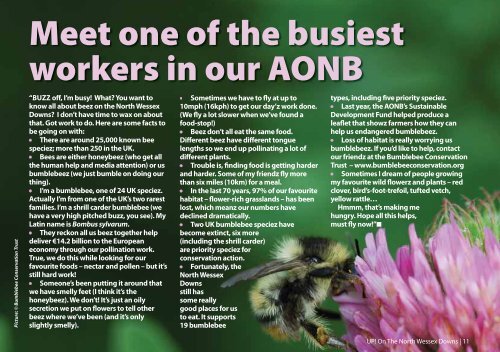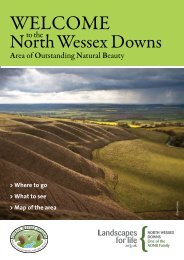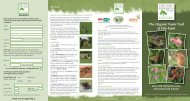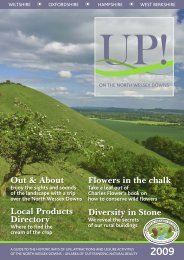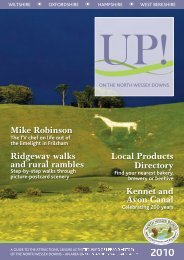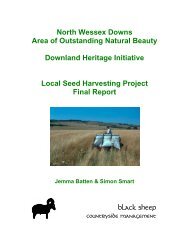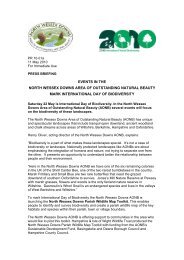UP! - North Wessex Downs Area of Outstanding Natural Beauty
UP! - North Wessex Downs Area of Outstanding Natural Beauty
UP! - North Wessex Downs Area of Outstanding Natural Beauty
You also want an ePaper? Increase the reach of your titles
YUMPU automatically turns print PDFs into web optimized ePapers that Google loves.
Meet one <strong>of</strong> the busiest<br />
workers in our AONB<br />
Picture: © Bumblebee Conservation Trust<br />
“BUZZ <strong>of</strong>f, I’m busy! What? You want to<br />
know all about beez on the <strong>North</strong> <strong>Wessex</strong><br />
<strong>Downs</strong>? I don’t have time to wax on about<br />
that. Got work to do. Here are some facts to<br />
be going on with:<br />
• There are around 25,000 known bee<br />
speciez; more than 250 in the UK.<br />
• Bees are either honeybeez (who get all<br />
the human help and media attention) or us<br />
bumblebeez (we just bumble on doing our<br />
thing).<br />
• I’m a bumblebee, one <strong>of</strong> 24 UK speciez.<br />
Actually I’m from one <strong>of</strong> the UK’s two rarest<br />
families. I’m a shrill carder bumblebee (we<br />
have a very high pitched buzz, you see). My<br />
Latin name is Bombus sylvarum.<br />
• They reckon all us beez together help<br />
deliver €14.2 billion to the European<br />
economy through our pollination work.<br />
True, we do this while looking for our<br />
favourite foods – nectar and pollen – but it’s<br />
still hard work!<br />
• Someone’s been putting it around that<br />
we have smelly feet (I think it’s the<br />
honeybeez). We don’t! It’s just an oily<br />
secretion we put on flowers to tell other<br />
beez where we’ve been (and it’s only<br />
slightly smelly).<br />
• Sometimes we have to fly at up to<br />
10mph (16kph) to get our day’z work done.<br />
(We fly a lot slower when we’ve found a<br />
food-stop!)<br />
• Beez don’t all eat the same food.<br />
Different beez have different tongue<br />
lengths so we end up pollinating a lot <strong>of</strong><br />
different plants.<br />
• Trouble is, finding food is getting harder<br />
and harder. Some <strong>of</strong> my friendz fly more<br />
than six miles (10km) for a meal.<br />
• In the last 70 years, 97% <strong>of</strong> our favourite<br />
habitat – flower-rich grasslands – has been<br />
lost, which meanz our numbers have<br />
declined dramatically.<br />
• Two UK bumblebee speciez have<br />
become extinct, six more<br />
(including the shrill carder)<br />
are priority speciez for<br />
conservation action.<br />
• Fortunately, the<br />
<strong>North</strong> <strong>Wessex</strong><br />
<strong>Downs</strong><br />
still has<br />
some really<br />
good places for us<br />
to eat. It supports<br />
19 bumblebee<br />
types, including five priority speciez.<br />
• Last year, the AONB’s Sustainable<br />
Development Fund helped produce a<br />
leaflet that showz farmers how they can<br />
help us endangered bumblebeez.<br />
• Loss <strong>of</strong> habitat is really worrying us<br />
bumblebeez. If you’d like to help, contact<br />
our friendz at the Bumblebee Conservation<br />
Trust – www.bumblebeeconservation.org<br />
• Sometimes I dream <strong>of</strong> people growing<br />
my favourite wild flowerz and plants – red<br />
clover, bird’s-foot-trefoil, tufted vetch,<br />
yellow rattle…<br />
Hmmm, that’s making me<br />
hungry. Hope all this helps,<br />
must fly now!”■<br />
<strong>UP</strong>! On The <strong>North</strong> <strong>Wessex</strong> <strong>Downs</strong> | 11


